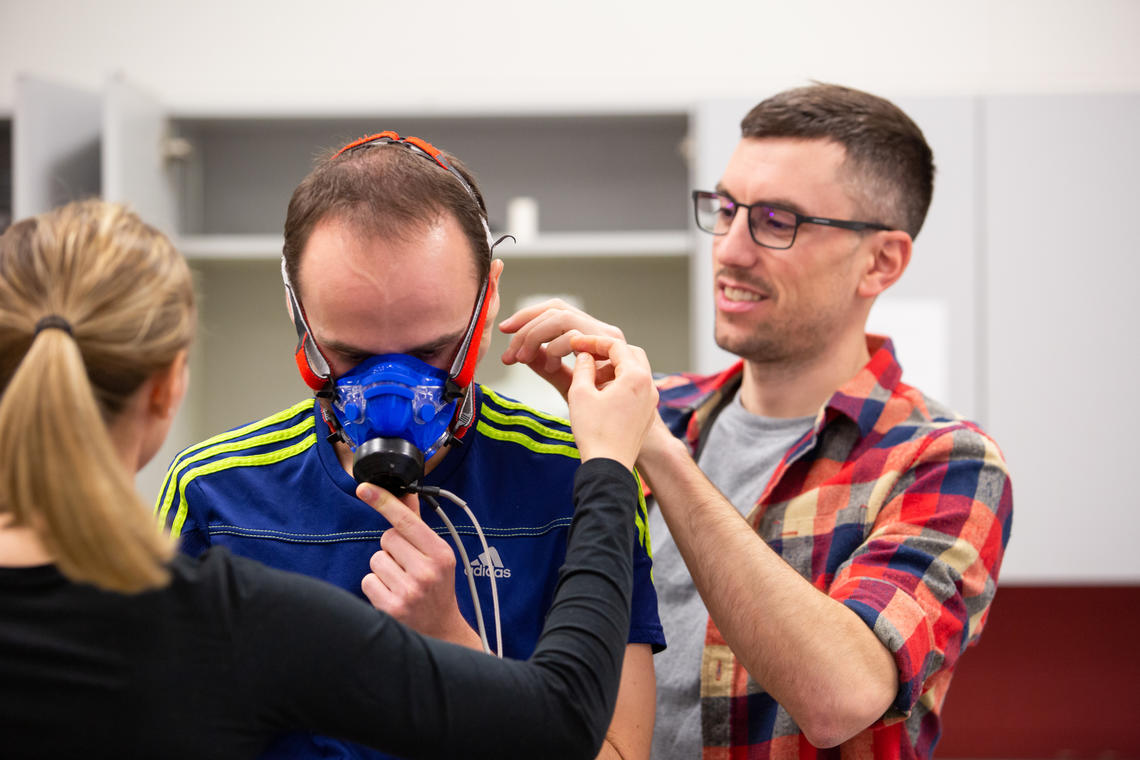Feb. 14, 2020
I heart exercise for Valentine’s Day

If exercise is medicine, what is the right dose? Kinesiology researchers are honing in on a “prescription” that will help individuals sustain an independent, high-quality life for as long as possible.
“Getting the right dose of exercise is important for everyone, especially for those over 65, the fastest growing segment of the Canadian population, which consumes 46 per cent of health-care budgets in Canada,” says Dr. Juan Murias, PhD, a researcher in the Faculty of Kinesiology at the University of Calgary.
Dr. Murias was senior author in a study published in Medicine & Science in Sports & Exercise exploring approaches to prescribing exercise intensity for men and women.

Postdoc Danilo Iannetta, right, sets up doctoral student Rafael Azevedo on an exercise machine.
Riley Brandt, University of Calgary
Strengthening health via exercise
In 2007, the American College of Sports Medicine launched the global Exercise is Medicine initiative encouraging physicians and other health-care providers “to make physical activity assessment and promotion a standard in clinical care, connecting health-care with evidence-based physical activity resources for people everywhere and of all abilities.”
The current gold standard for endurance exercise is a one-size-fits-all approach. The Canadian Physical Activity Guidelines for adults advises 150 minutes of moderate to vigorous aerobic physical activity per week, in bouts of 10 minutes or more.
What does moderate to vigorous mean for each individual? Kinesiology researchers’ study has demonstrated that the traditional methods of evaluating effort aren’t very precise — methods such as percentage of maximal heart rate or perceived effort, or even commonly used laboratory methods such as measuring maximal oxygen consumption (VO2max).
Current exercise zones not accurate
“This current one-size-fits-all approach for exercise fails to accurately classify the real intensity needed,” says Murias. “Current research indicates general daily physical activity is not always enough to trigger positive changes to the cardiovascular system to minimize the loss of function with aging,”
For example, brisk walking (between five and six km/h) would in theory represent a moderate stress on the cardiovascular system. However, when compared with another individual’s fitness, brisk walking might represent an intensity that puts the person in either the moderate (easy), the heavy (challenging but sustainable), or perhaps the severe (unsustainable for relatively long time) category of exercise.
For the exercise to be effective, the intensity needs to be high enough to work the cardiovascular system, allowing the heart, vessels, and muscles to improve oxygen transport. This can be achieved in many ways, and even in shorter durations than are typically recommended in guidelines (90-150 min/week), especially when exercise of very high intensity and very short duration (sprint interval training) is used.

Associate professor Juan Murias monitors Danilo Iannetta during a workout.
Seeking participants
To understand the right stimulus or dose of exercise, the researchers are testing intensity based on domains of exercise, often referred to as training zones, to understand what level of intensity or stress the body needs to produce positive adaptations that improve health outcomes.
Preliminary data suggests that there is a huge variability in the responses, based on the type of exercise, and that methods commonly used by researchers, coaches, athletes and trainers to prescribe exercise intensity often misclassify the effort that participants are actually doing, says researcher Dr. Martin MacInnis, PhD, Faculty of Kinesiology.
The researchers study ways to accurately prescribe exercise, so that participants find the domains or zones that truly maximize the benefits of endurance training programs.
The ultimate goal is improving cardiovascular function in the elderly, prolonging a healthy and independent life.To do that, researchers are seeking healthy, untrained/recreationally active men and women aged 18-45 and 60-85 years to participate in the study. Learn more about how you can get involved in the study.
Additional co-authors on A Critical Evaluation of Current Methods for Exercise Prescription in Women and Men are Dr. Danilo Iannetta, PhD, Erin Calaine Inglis, PhD student, and Anmol T. Mattu, MSc student in the Faculty of Kinesiology at the University of Calgary; Dr. Federico Y. Fontana, PhD, and Dr. Silvia Pogliaghi, MD/PhD, Department of Neurosciences, Biomedicine, and Movement Sciences, Verona, Italy; and Dr. Daniel Keir, University Health Network, Toronto.
Funders: Natural Sciences and Engineering Research Council of Canada and the Heart and Stroke Foundation of Canada





